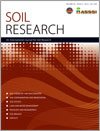SR11149Recovery of saturated hydraulic conductivity along a forest successional series from abandoned land to mature, evergreen broad-leaved forest in eastern China
With the climate change and deforestation, The relationship between vegetation succession and soil hydraulic properties has been concerned. The dynamic of soil hydraulic properties recovery at different time intervals is still under discussion. This study was made on several decades after deforestation, and it provides data about the deep layers (80 cm). The result indicated that improvement of soil hydraulic characteristics and mediation of overland flow related to increasing in macroporosity and root biomass as advancement of forest succession.




